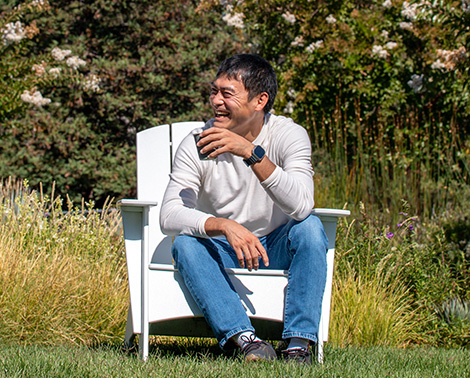Kato
Actually, I had no plans to tackle infrastructure. In 2013, I participated in the DARPA Robotics Challenge Trials 2013, a world competition for humanoid robots organized by the U.S. Department of Defense, which led to the sale of SCHAFT to Google, and many robot technology-related conversations began to come my way. Among these, I was particularly interested in a snake-shaped robot technology for inspecting pipes, which utilizes technological seeds from the Tokyo Institute of Technology. I wanted to commercialize this technology, but it's difficult to monetize by simply saying "we can inspect your plumbing.” In the course of our market research, we discovered there would be money in it if we could do in-depth inspections of the pipes used in oil refinery heat exchangers. It was then that we established our first contacts in the oil and gas industry.
From that point on, we visited oil and gas trade shows, ran stalls at exhibitions, and visited actual oil refineries to deepen our knowledge of the market, and came face-to-face with a lot of oil and gas-related pipes. We came to learn, however, that it can take years to get certified for oil and gas, and that simpler and cheaper methods are available. Then we thought that water might be a good choice. Eventually, we were asked by a water company in Oakland to check pipes—around 6,000km's worth—using a snake-shaped robot. But a snake robot can't operate over 6,000 kilometers. So the scope of the technology changed to the point where it would be better to create analysis software, even if the accuracy were to be slightly reduced. We thought it would be revolutionary if we could use software to monitor the condition of underground water pipes, like taking photographs, and we felt there might be a market for this. Of course it is from this perspective that entrepreneurs enter a market, with one eye on the size of the market, and the other on whether there is a technological advantage that can be applied there. So I had kind of become hooked on infrastructure before I even knew it.

Kibe
The reason we focused on water and sewerage is the market. Investors, especially managers of pension assets of pension funds (*1), invest in secondaries. Between 20% and 30% of U.S. pension investments are in infrastructure. This is because, unlike stocks, pension investments exhibit lower volatility and long-term stability. Of all infrastructure, water is the one that pension managers like the most. The things closest to our daily lives are the least volatile. Even if another Great Financial Crisis comes our way, we will still use water. And so the infrastructure that isn't affected by the economy, pandemics, etc., is water and sewerage. If you ask about getting into the water supply business in Japan, you'll be told that there's no profit in it, and why would sewerage be any different ? When we thought about being the first in Japan to try the business model of exiting to pension funds, as they do in Europe, we decided that waterworks would actually be most popular in the secondary market.
In the UK, management is already IT and digital, and although deterioration diagnostics are still only partially implemented, operations are considerably more streamlined and ahead of their time in terms of energy conservation and CO2 reduction. Because I come from a civil engineering background, I understand how difficult it is to manage something that cannot be seen, and at the same time, that is precisely the point . However, if we become able to use IT and digital systems to observe and monitor the condition of these unseen assets and become able to make data-driven predictions about deterioration, the business possibilities will expand greatly.
Kibe Japan is idiosyncratic in its high costs. And it's in a situation where those costs are covered by taxes and public funds, but the public is not informed of this.
Kato When comparing Japan with the U.S. and the U.K., people tend to say that Japan's water supply is excellent, its leakage rates are low, the pipes are clean, and Japan is a leader in infrastructure. Yet we have not become a leader in finance, and in some ways I believe we have a very inefficient approach to investment. Inefficiencies have been covered over with taxpayers' hard-earned money.
Kibe The first important thing is to "visualize." Consider where there is waste and what makes it different compared to how it is managed in Europe, the U.S., and other countries. Japanese management places a strong emphasis on the engineering perspective. Both Mr. Kato and I started out as engineers, so we understand the desire to create something good even if it costs a little more. In a sense, it is a beautiful thing, but from a financial perspective, there has been no discussion about who should bear the costs, how far the technology should be mastered, and who should bear the burden of achieving full marks. During the high-speed economic growth period, no one paid much attention to cost.
Kibe Japan is said to be a country with advanced issues, but when it comes to infrastructure maintenance and management, Europe and other countries are facing challenges ahead of us.
Kato Be it Japan, the U.S., or Europe, the pattern is exactly the same when it comes to infrastructure: an accident happens and people are surprised, only then do they start to get angry and ask why it happened. But everyone understands when we tell them, "It's because it's been 300 years since it was built." So I think one significance of our technology is bringing this to light, exposing it for all to see. If we can show everyone things that are buried, much like sonar (*2), we can see how much infrastructure is deteriorating, and if we know this, we will naturally be motivated to fix it. It's like when we become aware that we are ill. People who do not believe they are ill will of course not seek treatment. And the first step in having a person understand that they are ill is to have them take a test and have them come to that awareness based on objective facts.
Kibe The question of how to make visible that which is invisible in infrastructure is an important one. Instead of digging up or removing it to check its condition, create a system that can predict it. This has become possible with the development of digital, ICT, and sensors, and furthermore, if we can create algorithms using that data, the accuracy of predictions will increase dramatically.
Kibe The immediate challenge is how to collect data. Large numbers of sensors are embedded in the water pipes of advanced large European cities. The more sensors you have, the more accurate and detailed data you can collect, but it is important to invest in sensors and systems while streamlining and monetizing management. In Japan, we have information in paper format and in PDFs, but that cannot be treated as data, and the cost to turn it into usable electronic data would be too great in terms of time and money. That’s why we need sensors. We need a system that automatically gathers data in the cloud.

Kato I believe that one effective way to further improve the accuracy of calculating the probability of the presence of small holes and cracks in water pipes that can lead to leaks is to increase the amount of data that can be analyzed through INFRONEER's concession business expansion, and to repeat computer-based experiments using more data to improve modeling accuracy. Another approach, assuming that the amount of data in Japan is not yet sufficient for the situation, is to convert much of the data that Fracta has obtained in the U.S. and Europe into a Japanese version. The problem of deterioration of pipe surfaces, i.e., the oxidation of iron pipes, is a chemical problem, so whether in Japan, the United States, or Europe, all pipes are the same in terms of rusting. If you have rules that bring together environmental information such as soil, pipe types, humidity, and temperature, you can convert algorithms created in the U.S. to suit the Japanese context.
Kibe Just like in clinical trials, there are cases where drugs that have been tested overseas may not match the characteristics of the Japanese physiology even though the subjects are the same in the sense that they are both humans. In such cases, the person who is able to determine the difference between clinical trial patients and Japanese people, and how to modify drugs accordingly, will win.
Kato Genetically, they are 88% the same, so I think it's only a question of using algorithms for the other 12% difference to bring it up to 100%. Similarly, we’ve conducted a number of experiments with these methods in the process of reimporting the Fracta technology from the U.S. to Japan.
Kibe So at some point, you can figure out the effect of things like the iron content of the soil. In doing so , we will understand the constants and multipliers when performing the conversion. This will allow us to do the same thing with less Japanese data. That's the interesting thing about statistics, and being able to discover things like that is what makes data-driven processes so interesting.